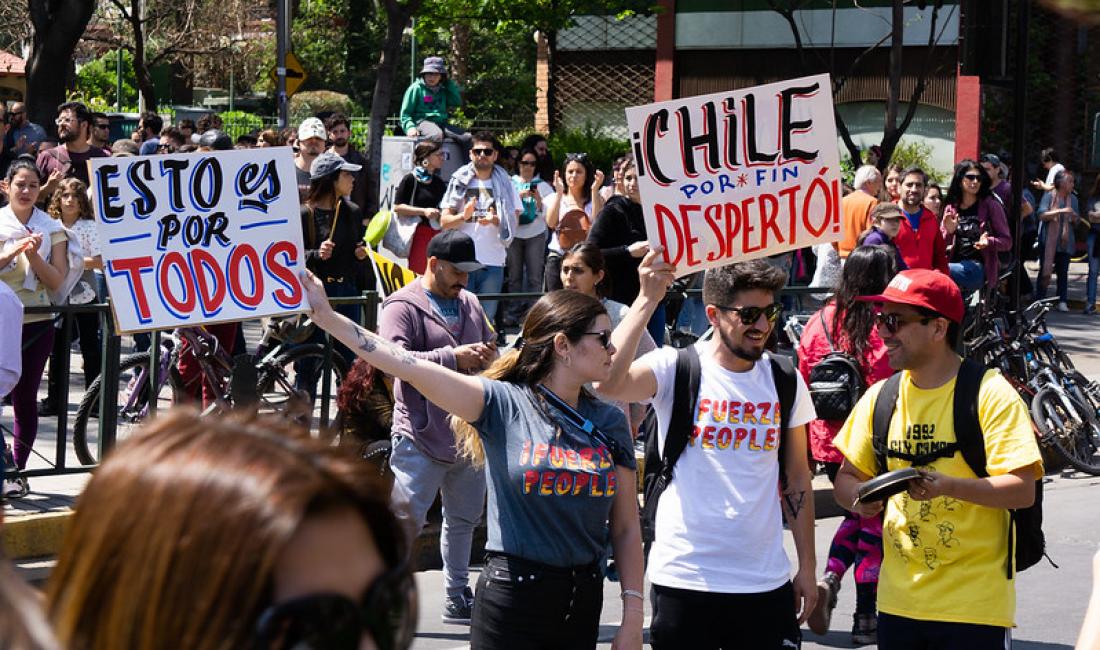Since October, Chile has seen tremendous social uprising across the country. What started as a protest about rising fares for the subway quickly grew into a broader protest about inequality and political exclusion. The situation even led into a 10-day long state of emergency, declared by President Sebastian Piñera.
The country is, in terms of economic growth and GDP (Gross Domestic Product), an exception in Latin America, but it doesn’t see fair distribution of its wealth. Instead, Chile is the seventh most unequal country in the world according to its Gini Index, an often-used parameter to measure income distribution. The country knows an extremely regressive tax system. Health, education and water are privatised and most of the lower- and middle classes are in debt. Pensions are meagre, forcing many citizens to work their entire life. Moreover, there is a huge gap between the citizens and the political class. “While parliamentarians receive payments that amount to thirty times the minimum wage, a large part of the Chilean population is only able to make a living on the basis of consumer loans” explains Ingrid Wehr, head of the Cono Sur office from the German Heinrich-Böll-Stiftung in Chile. People seem to be fed up with the stark contradiction between economic growth and precariousness and demand their share of the cake.
In this environment of public discontent, the price hike for metro tickets seemed to be the straw that broke the camel’s back. Mostly peaceful protest quickly turned grim by a tremendous repressive crack-down by Piñera’s armed forces and the police apparatus, leaving dozens dead and hundreds injured. The aggressive reaction of the state quickly was followed by measures to calm the waters. Among other things, Piñera shuffled his cabinet, guaranteed better pensions and promised to trigger a plebiscite on whether and how to rewrite the constitution. This plebiscite will be held April, 26 2020.
Why are the protesters demanding a new constitution?
Much of the protesters ́ anger has focused on Chile ́s 1980 constitution. The reasons for that are manifold. In 1980, the regime of Pinochet wrote the document and put it up for a plebiscite, where it got approved. The document marked the end of Pinochet's rule. However, his spirit remained alive in the content of the constitution, as it privileged the conservative, Pinochetean parts of society. According to Sergio Verdugo, constitutional expert and associate professor of Law at the Universidad del Desarrollo in Chile, the constitution even included authoritarian enclaves that granted the military formal political powers.
Some changes have been made until now, as the constitution was amended several times and the majority of the articles were modified. In 2005 the authoritarian enclaves were removed. Furthermore, Michelle Bachelet, Piñera’s predecessor, listened to popular demand for change and proposed to replace the entire constitution by letting citizens decide on the content of the new constitution. She was successful in her attempt to include citizens in the constitution building process, but she failed to generate support from political parties in the process. This led eventually to the fall of the project.
In spite of changes, many still see the document as a remnant of an authoritarian past. An embodiment of Augusto Pinochet’s neoliberal model, prioritizing a market-driven economy but failing to sufficiently guarantee healthcare, education and pensions.
Verdugo also talks about unpopular rulings of the constitutional courts that helped create a belief that the constitution prevents the realization of a social-democrat agenda. For example, one of the rulings of the courts prevented the implementation of Bachelet’s labour program reforms aimed at enhancing the power of the unions. According to the interpretation of the constitutional courts, these reforms were incompatible with the freedom of association.
In light of recent protests, which were fuelled by public discontent about social and political rights, and mostly material conditions, a new constitution is seen as a vehicle that is broad enough to unify all these different demands. As such, it does not come as a surprise that the protesters believe that a new constitution can help realize the goals of the movement on the streets.
Back to the future: What will the new constitution building process look like?
After the past months of unrest, Gonzalo Blumel, Piñera’s new interior minister after the cabinet shuffle, negotiated a national accord, published on November, 15, for a plebiscite in April, the Acuerdo por la Justicia Social y un Acuerdo por una Nueva Constitución. April ́s ballot will ask two things: do Chilean citizens want a new constitution? And, if they do, which body should write this constitution: a constituent assembly of only citizens or a mixed constituent assembly with citizens and legislators alike? All parties except some on the far left and the far right have signed the agreement.
After signing the agreement, the installation of a ́ ́Technical Commission ́ ́ was the next step towards the new Magna Carta. It consists of 14 politically appointed delegates from all agreeing parties. Most of the appointees are lawyers, political scientists and constitutional experts. The commission is equally formed by seven members representing governing parties and seven members representing the opposition. One of the delegates is Claudia Heiss from the left-wing party Revolución Democrática, political scientist and constitutional expert. She pointed out the Commission ́s exact task:
“The agreement had 12 points and was meant to open a process of constitutional replacement.[...] The norms in the new Constitution would have to be approved by 2/3 of either of these Conventions and the final text would be submitted to a national plebiscite. From the broad lines established in the agreement, the Technical Committee was requested to design the specific constitutional reforms and legal adjustments needed to make all of these announcements happen according to established norms and political institutions.”
Furthermore, Claudia Heiss talked about the decision-making legitimacy of the Commission:
“[...] its discussions are transmitted via streaming by the TV channel of the Senate. Transparency is key to give legitimacy to this process and to future constitution-making.”
Even though this first agreement seemed to be step in the right direction, many questioned it´s stability and completeness. According to Verdugo, the process was very fragile and the agreement incomplete. Claudia Heiss also acknowledged that the parties only agreed on the process of realizing a new constitution.
What remained unknown were possible quorums guaranteeing the participation of indigenous people and clauses realizing gender parity. Similar questions were raised by almost 200 civil organisations and trade unions, joined in the Mesa de Unidad Social. Next to the abovementioned, they warned of a possible scenario in which the right-wing could reach a blocking minority because of the high quorum of ⅔ that is necessary to the adoption for the new constitution. The explicit exclusion of young people from 16 until 18 years old is another point of critique for the Mesa. The next generation stood at the forefront of the protests and their voices have become loud. Why should they not have a role in shaping the future? These missing details are not irrelevant, because they represent deep-seated rifts in Chilean society. Ongoing disagreement on these matters can lead to serious destabilization of the constitutional process.
All eyes were on the Technical Commission on December, 6 as they reached their final agreement. The outcome disappointed many, because the agreement barely differed from the document published on November, 15. The final outcome did not guarantee gender equality in the constituent convention and did not mention a quorum for securing participation of indigenous people. Other important matters were barely touched upon: questions asking whether individual candidates can receive financial support to create a level playing field for members of the constituent assembly have remained unanswered. Right after the official announcement of the December 6 accord, the opposition quickly published a statement in which they vowed to process these quorums through legislative processes, for which they have time until June, 25 2020. In turn, that move was criticized by delegates of the right-wing governing coalition of Chile Vamos, that declared that the opposition is jeopardizing the November 15 agreement.
The final document has to be converted into law before December, 28, as it will authorize the plebiscite that makes a new constitution possible. If, in April the people of Chile vote in favour of a new constitution, the selected convention (mixed or full-citizen) will proceed to write a new constitution.
The process of constitution writing, how does it work?
In the coming April plebiscite, citizens will have two options on how the constitution should be written: by a mixed constituent convention or a full-citizen convention.
The mixed convention will consist of 172 members, equally divided between parliamentarians elected by congress and chosen citizens. This vote will take place in October 2020, simultaneous with local and provincial elections. According to the Chilean Organic Constitutional Law on Popular Votes and Scrutinies, which is the basis for the constitutional reform, participating citizens are not allowed to be connected to any political party in the nine months before they present themselves. In the case of a citizen-only convention, the body will consist of 155 citizens chosen through a similar district system.
Voting for the final document
The convention has to propose the text for the new constitution within a term of 9 months, which can be extended, only once, by three months. The extension can be requested by a third of the members of the convention.
Sixty days after publication of the final text, a new plebiscite would approve or reject the new constitution. Voting will be mandatory, otherwise people risk receiving penalties that could add up to the amount of 500 US-dollar. Lastly, the outcomes of the final vote have to be ratified through parliament.
There are high hopes for this constitution-making process, but a new constitution is no magic potion that will resolve the complex dynamics of Chilean socio-political problems. With all the shortcomings of the current accord, it is unclear how this process will gain legitimacy of the people. It is also unclear what will happen if the left is unable to advance the quorums for women and indigenous people. Further political strife could even break-down the entire process and ongoing rivalries could impair political agreement that aim to advance the social agenda.
At the time of writing this article, protests have not stopped and Piñera is under pressure because of accusations of human rights abuses committed by the national police and other state's organs. As such, one of the biggest question marks is his position. It is unclear if Piñera ́s government will even make it until April...
Copyright picture: Diego Correa (CC BY 2.0), https://creativecommons.org/licenses/by/2.0/




